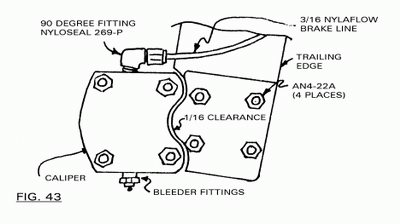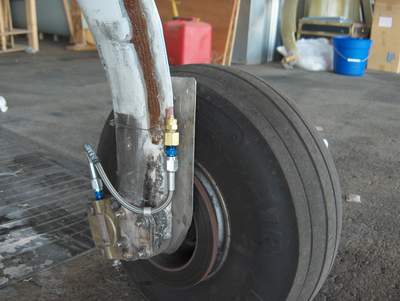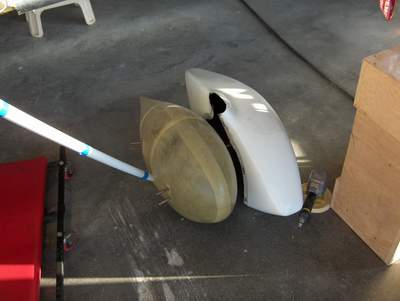As I mentioned in a previous posting, I had a mishap on the way back from Oshkosh this year where I clipped a barricade when landing at Plattsmouth, NE. It resulted in a severed brake line and one destroyed wheelpant. Fortunately, I was able to make a temporary repair using parts from a hardware store with the generous help of an RV builder by the name of Kevin Faris. Over the past few weeks, I’d been thinking about how best to repair the damage to the brake line and decided to make some upgrades to the brake lines on both sides. My friend Don has always had considerable consternation over the way that my Nylaflow brake lines were connected directly to the brakes, even though it is done exactly according to the LongEZ plans. Even the Cozy MKIV plans call out the same approach as shown below.
The caliper is in close contact with the brake pads and so it absorbs a lot of heat. It gets hot enough that sometimes after taxiing in a crosswind, you can’t touch the fittings on the caliper without burning yourself. In a crosswind, the EZ-style planes will tend to try to point into the wind and so you have to apply the downwind brake to keep them from turning. One of the techniques EZ flyers use to reduce heat from the brakes during a crosswind taxi is stabbing the downwind brake periodically to steer away from the wind and then letting the plane weathervane into the wind while taxiing so that you make a series of semi circles along the taxiway. It may look a little strange, but it really helps to prevent a brake from overheating. There’s nothing worse than dragging a brake for an extended period of time to generate excessive heat. In some cases, this has been enough to melt the gear leg which is made of fiberglass and epoxy. When that happens, you’ve got a big repair job ahead of you. But melting a brake line can be very serious too because the LongEZ needs them not only to stop, but also to steer and when you’ve lost the ability to steer, you can end up off the runway and into a ditch or obstacle.
The advice in the Cozy plans is to wrap the Nylaflow brake lines in a thin blanket of ceramic material called Fiberfrax where it attaches to the brake. This material is glued in place with silicone and wrapped with aluminum tape to act as an insulator from the heat radiated from the brake disk. As you can imagine, it makes a mess of things and it doesn’t help with the heat conducted from the fittings on the brake. Another solution recommended by my friend Don and which he uses himself is to install a section of Teflon line with a stainless steel braid covering between the Nylaflow line and the brakes. These are available in standard lengths for about $10. I bought a few of these made by Earl’s Performance in 10-inch lengths (p/n EAR-63010110ERL) from Summit Racing. They are pressure tested to 4000 psi, well above the 1000 psi rating of the Nylaflow tubing.
Nylon, the material from which Nylaflow is made, has a continuous service temperature of about 200 degrees F. Teflon has a continuous service temperature of 500 degrees F. In addition to making this upgrade to the brake lines, I also sliced into the rear of the landing gear and removed the old Nylaflow lines that had been in there for 23 years. I have wanted to do this ever since I bought the plane. The LongEZ manual called for the brake lines to be installed and covered with fiberglass/epoxy, making it somewhat of a permanent installation. The Cozy plans recommended using a tunnel constructed of soda straws and held in place with a covering of fiberglass and epoxy so that the Nylaflow lines can be slipped through it removed and replaced easily. We also made this change to the gear legs on both sides.
I’ve ordered some new wheel pants from Van’s that are called ‘pressure recovery’ wheelpants and should work better than the football shaped wheel pants that I had previously. The football pants were not very effective in reducing drag. Kevin gave me this tip and so I took a picture of my football shaped wheelpant setting next to his pressure recovery style wheelpant and his definitely looks more aerodynamic.
The next upgrade I’m considering is to add fairings to the gear legs that would be more aligned with the direction of flight. The standard gear, which appears to be shaped like an airfoil, isn’t really an airfoil and isn’t very well aligned with the direction of flight. This is a lot of work and I’m reading through the newsletters from the Central States Association to see if I want to tackle a project like that while I’m installing the new wheel pants.
I’ve also added some of the photos I took at Oskhosh here.





Pingback: Back from Oshkosh… | Lee Devlin's Website
Hi Lee
I would like to convert my brake lines over using the 10″ Earls Performance brake lines which I have already ordered. Do you recall what the other fittings are? Which AN fittings and Poly-Flo or Nylo Flow fitting did you use?
Thanks Paul, Long EZ 214LP